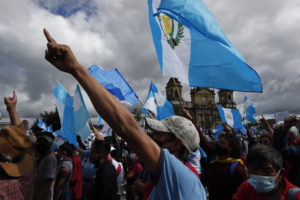THE NORTHERN TRIANGLE IN DATA
Guatemala
The Central America Monitor presents robust quantitative data primarily obtained through official information requests in several key areas. These data assess advances, setbacks, or stalling on specific human rights and rule of law issues from 2014 to 2021. Below, start by viewing the data regionally or clicking on a country. Then, select a section. Under each section, select a specific indicator to explore the corresponding data points. You may also download the raw data or share the graphics.
Guatemala has high levels of inequality and poverty. In this section, we display its socioeconomic situation as background for all subsequent sections. We aim to provide broad centralized and reliable data that can serve as a starting point for further investigation. As such, we decided to include disaggregated data only when immediately relevant to the sections we monitor.
!function(){“use strict”;window.addEventListener(“message”,(function(a){if(void 0!==a.data[“datawrapper-height”])for(var e in a.data[“datawrapper-height”]){var t=document.getElementById(“datawrapper-chart-“+e)||document.querySelector(“iframe[src*='”+e+”‘]”);t&&(t.style.height=a.data[“datawrapper-height”][e]+”px”)}}))}();
Note: The data shown are derived from estimated population statistics published by the Guatemalan government. They were last updated in 2019; consequently the data here differ from the data published in the Central America Monitor’s baseline reports.
Source: National Institute of Statistics of Guatemala.
!function(){“use strict”;window.addEventListener(“message”,(function(a){if(void 0!==a.data[“datawrapper-height”])for(var e in a.data[“datawrapper-height”]){var t=document.getElementById(“datawrapper-chart-“+e)||document.querySelector(“iframe[src*='”+e+”‘]”);t&&(t.style.height=a.data[“datawrapper-height”][e]+”px”)}}))}();
Source: National Institute of Statistics of Guatemala.
!function(){“use strict”;window.addEventListener(“message”,(function(a){if(void 0!==a.data[“datawrapper-height”])for(var e in a.data[“datawrapper-height”]){var t=document.getElementById(“datawrapper-chart-“+e)||document.querySelector(“iframe[src*='”+e+”‘]”);t&&(t.style.height=a.data[“datawrapper-height”][e]+”px”)}}))}();
Note: The Guatemalan government does not update its population projections annually by race or ethnicity. Consequently, the figures shown in a given year derive from the last census that took place (2002 and 2018) . According to the groups denominated in the Guatemalan censuses, figures shown include Mayan, Xinca, and Garífuna people.
Source: 2002 and 2018 population censuses of Guatemala.
!function(){“use strict”;window.addEventListener(“message”,(function(e){if(void 0!==e.data[“datawrapper-height”]){var t=document.querySelectorAll(“iframe”);for(var a in e.data[“datawrapper-height”])for(var r=0;r<t.length;r++){if(t[r].contentWindow===e.source)t[r].style.height=e.data["datawrapper-height"][a]+"px"}}}))}();
Note: The Guatemalan government does not update its population projections annually by race or ethnicity. Consequently, the figures shown in a given year derive from the last census that took place (2018 in Guatemala). Guatemala’s 2002 census did not include denominations for afro-descendants.
Source: 2002 and 2018 population censuses of Guatemala.
!function(){“use strict”;window.addEventListener(“message”,(function(a){if(void 0!==a.data[“datawrapper-height”])for(var e in a.data[“datawrapper-height”]){var t=document.getElementById(“datawrapper-chart-“+e)||document.querySelector(“iframe[src*='”+e+”‘]”);t&&(t.style.height=a.data[“datawrapper-height”][e]+”px”)}}))}();
Source: World Bank.
!function(){“use strict”;window.addEventListener(“message”,(function(a){if(void 0!==a.data[“datawrapper-height”])for(var e in a.data[“datawrapper-height”]){var t=document.getElementById(“datawrapper-chart-“+e)||document.querySelector(“iframe[src*='”+e+”‘]”);t&&(t.style.height=a.data[“datawrapper-height”][e]+”px”)}}))}();
Source: World Bank.
!function(){“use strict”;window.addEventListener(“message”,(function(e){if(void 0!==e.data[“datawrapper-height”]){var t=document.querySelectorAll(“iframe”);for(var a in e.data[“datawrapper-height”])for(var r=0;r<t.length;r++){if(t[r].contentWindow===e.source)t[r].style.height=e.data["datawrapper-height"][a]+"px"}}}))}();
Sources: Ministry of Labor and Social Welfare and Bank of Guatemala.
!function(){“use strict”;window.addEventListener(“message”,(function(e){if(void 0!==e.data[“datawrapper-height”]){var t=document.querySelectorAll(“iframe”);for(var a in e.data[“datawrapper-height”])for(var r=0;r<t.length;r++){if(t[r].contentWindow===e.source)t[r].style.height=e.data["datawrapper-height"][a]+"px"}}}))}();
Note: Figures shown were taken from the World Bank, which included the following note: “GDP at purchaser’s prices is the sum of gross value added by all resident producers in the economy plus any product taxes and minus any subsidies not included in the value of the products. It is calculated without making deductions for depreciation of fabricated assets or for depletion and degradation of natural resources. Data are in current U.S. dollars. Dollar figures for GDP are converted from domestic currencies using single year official exchange rates. For a few countries where the official exchange rate does not reflect the rate effectively applied to actual foreign exchange transactions, an alternative conversion factor is used.”
Source: World Bank (accessed June 2021).
!function(){“use strict”;window.addEventListener(“message”,(function(e){if(void 0!==e.data[“datawrapper-height”]){var t=document.querySelectorAll(“iframe”);for(var a in e.data[“datawrapper-height”])for(var r=0;r<t.length;r++){if(t[r].contentWindow===e.source)t[r].style.height=e.data["datawrapper-height"][a]+"px"}}}))}();
Note: All amounts have been converted to United States Dollars using an exchange rate of 7.7 Guatemalan Quetzales.
Sources: Ministry of Labor and Social Welfare and Bank of Guatemala.
!function(){“use strict”;window.addEventListener(“message”,(function(e){if(void 0!==e.data[“datawrapper-height”]){var t=document.querySelectorAll(“iframe”);for(var a in e.data[“datawrapper-height”])for(var r=0;r<t.length;r++){if(t[r].contentWindow===e.source)t[r].style.height=e.data["datawrapper-height"][a]+"px"}}}))}();
Notes: All amounts have been converted to United States Dollars using an exchange rate of 7.7 Guatemalan Quetzales. The figures shown were calculated to represent per capita costs of basic provisions, known as the “basic basket of goods” (canasta básica). In Guatemala, the figures represent the average rates of “basic vital goods” (canasta básica vital) and “basic expanded goods” (canasta básica ampliada) from January 2014 through September 2017, and the new “basic expanded goods” rate as of October 2017.
Source: National Statistics Institute of Guatemala.
!function(){“use strict”;window.addEventListener(“message”,(function(e){if(void 0!==e.data[“datawrapper-height”]){var t=document.querySelectorAll(“iframe”);for(var a in e.data[“datawrapper-height”])for(var r=0;r<t.length;r++){if(t[r].contentWindow===e.source)t[r].style.height=e.data["datawrapper-height"][a]+"px"}}}))}();
Source: National Statistics Institute of Guatemala.
!function(){“use strict”;window.addEventListener(“message”,(function(e){if(void 0!==e.data[“datawrapper-height”]){var t=document.querySelectorAll(“iframe”);for(var a in e.data[“datawrapper-height”])for(var r=0;r<t.length;r++){if(t[r].contentWindow===e.source)t[r].style.height=e.data["datawrapper-height"][a]+"px"}}}))}();
Note: The poverty rate in Guatemala derives from the 2014 census. There are no available updated figures after this year, so we have listed the same rate for ensuing years.
Source: National Statistics Institute of Guatemala.
!function(){“use strict”;window.addEventListener(“message”,(function(e){if(void 0!==e.data[“datawrapper-height”]){var t=document.querySelectorAll(“iframe”);for(var a in e.data[“datawrapper-height”])for(var r=0;r<t.length;r++){if(t[r].contentWindow===e.source)t[r].style.height=e.data["datawrapper-height"][a]+"px"}}}))}();
Note: The literacy rate refers to the percentage of people who can read and write, and includes those older than 14 years in Guatemala. No data were available for 2016, 2018, 2019, or 2020.
Source: National Statistics Institute of Guatemala; World Bank.
!function(){“use strict”;window.addEventListener(“message”,(function(e){if(void 0!==e.data[“datawrapper-height”]){var t=document.querySelectorAll(“iframe”);for(var a in e.data[“datawrapper-height”])for(var r=0;r<t.length;r++){if(t[r].contentWindow===e.source)t[r].style.height=e.data["datawrapper-height"][a]+"px"}}}))}();
Source: World Bank.
Amidst the very high levels of violence for the general population in Guatemala, human rights defenders, activists, journalists, justice system officials, lawyers, LGBTQ+ persons, and trade unionists face among the highest rates of threats, aggressions and killings in the world. We show how even for their higher profile cases, few actually enter the justice system and end in sentencing.
!function(){“use strict”;window.addEventListener(“message”,(function(e){if(void 0!==e.data[“datawrapper-height”]){var t=document.querySelectorAll(“iframe”);for(var a in e.data[“datawrapper-height”])for(var r=0;r<t.length;r++){if(t[r].contentWindow===e.source)t[r].style.height=e.data["datawrapper-height"][a]+"px"}}}))}();
Note: The figures show the total number of legal complaints received by corresponding specialized prosecutorial units, which include: Prosecution Unit on Crimes against Human Rights; Prosecution Unit on Crimes against Activists; Prosecution Unit on Crimes of Discrimination; Prosecution Unit on Crimes against Justice Officials and Trade Unionists.
Source: Public Prosecutor’s Office.
!function(){“use strict”;window.addEventListener(“message”,(function(e){if(void 0!==e.data[“datawrapper-height”]){var t=document.querySelectorAll(“iframe”);for(var a in e.data[“datawrapper-height”])for(var r=0;r<t.length;r++){if(t[r].contentWindow===e.source)t[r].style.height=e.data["datawrapper-height"][a]+"px"}}}))}();
Note: Figures represent the total number of legal complaints for killings, homicides, threats, and assaults received by the Prosecution Unit on Crimes against Activists and the Prosecution Unit on Crimes against Human Rights.
Source: Public Prosecutor’s Office.
!function(){“use strict”;window.addEventListener(“message”,(function(e){if(void 0!==e.data[“datawrapper-height”]){var t=document.querySelectorAll(“iframe”);for(var a in e.data[“datawrapper-height”])for(var r=0;r<t.length;r++){if(t[r].contentWindow===e.source)t[r].style.height=e.data["datawrapper-height"][a]+"px"}}}))}();
Note: It was only possible to obtain data regarding complaints filed with the Human Rights Ombudsperson’s Office against members of the Armed Forces, not the National Civilian Police.
Source: Human Rights Ombudsperson’s Office.
!function(){“use strict”;window.addEventListener(“message”,(function(e){if(void 0!==e.data[“datawrapper-height”]){var t=document.querySelectorAll(“iframe”);for(var a in e.data[“datawrapper-height”])for(var r=0;r<t.length;r++){if(t[r].contentWindow===e.source)t[r].style.height=e.data["datawrapper-height"][a]+"px"}}}))}();
Note: The figures shown include the number of prosecutors and assistant prosecutors in the Public Prosecutor’s Office for Human Rights. The Monitor requested data regarding staff and finances disaggregated by subunits, but the Public Prosecutor’s Office indicated this disaggregated was not possible. These subunits include: Prosecution Unit on Crimes of Discrimination; Unit on Special Cases from the Internal Armed Conflict; Special Prosecution Unit on Crimes against Trade Unionists; Unit on Crimes against Journalists; Prosecution Unit on Crimes against Human Rights Activists; Prosecution Unit on Crimes against Human Rights; and Prosecution Unit on Crimes against Justice Officials.
Source: Public Prosecutor’s Office.
!function(){“use strict”;window.addEventListener(“message”,(function(e){if(void 0!==e.data[“datawrapper-height”]){var t=document.querySelectorAll(“iframe”);for(var a in e.data[“datawrapper-height”])for(var r=0;r<t.length;r++){if(t[r].contentWindow===e.source)t[r].style.height=e.data["datawrapper-height"][a]+"px"}}}))}();
Note: The figures shown include the funds allocated to the Public Prosecutor’s Office for Human Rights. All amounts have been converted to United States Dollars using an exchange rate of 7.7 Guatemalan Quetzales. The Monitor requested data regarding staff and finances disaggregated by subunits, but the Public Prosecutor’s Office indicated this disaggregated was not possible. These subunits include: Prosecution Unit on Crimes of Discrimination; Unit on Special Cases from the Internal Armed Conflict; Special Prosecution Unit on Crimes against Trade Unionists; Unit on Crimes against Journalists; Prosecution Unit on Crimes against Human Rights Activists; Prosecution Unit on Crimes against Human Rights; and Prosecution Unit on Crimes against Justice Officials.
Source: Public Prosecutor’s Office.
!function(){“use strict”;window.addEventListener(“message”,(function(e){if(void 0!==e.data[“datawrapper-height”]){var t=document.querySelectorAll(“iframe”);for(var a in e.data[“datawrapper-height”])for(var r=0;r<t.length;r++){if(t[r].contentWindow===e.source)t[r].style.height=e.data["datawrapper-height"][a]+"px"}}}))}();
Note: The figures shown refer to staff assigned to high risk courts. As these courts have jurisdiction on issues of human rights, corruption, organized crime and violence, the information in this section is also found in other areas of this website under corresponding categories.
Source: Judiciary of Guatemala.
!function(){“use strict”;window.addEventListener(“message”,(function(e){if(void 0!==e.data[“datawrapper-height”]){var t=document.querySelectorAll(“iframe”);for(var a in e.data[“datawrapper-height”])for(var r=0;r<t.length;r++){if(t[r].contentWindow===e.source)t[r].style.height=e.data["datawrapper-height"][a]+"px"}}}))}();
Note: All amounts have been converted to United States Dollars using an exchange rate of 7.7 Guatemalan Quetzales. The figures shown refer to funds allocated to high risk courts. As these courts have jurisdiction on issues of human rights, corruption, organized crime and violence, the information in this section is also found in other areas of this website under corresponding categories.
Source: Judiciary of Guatemala.
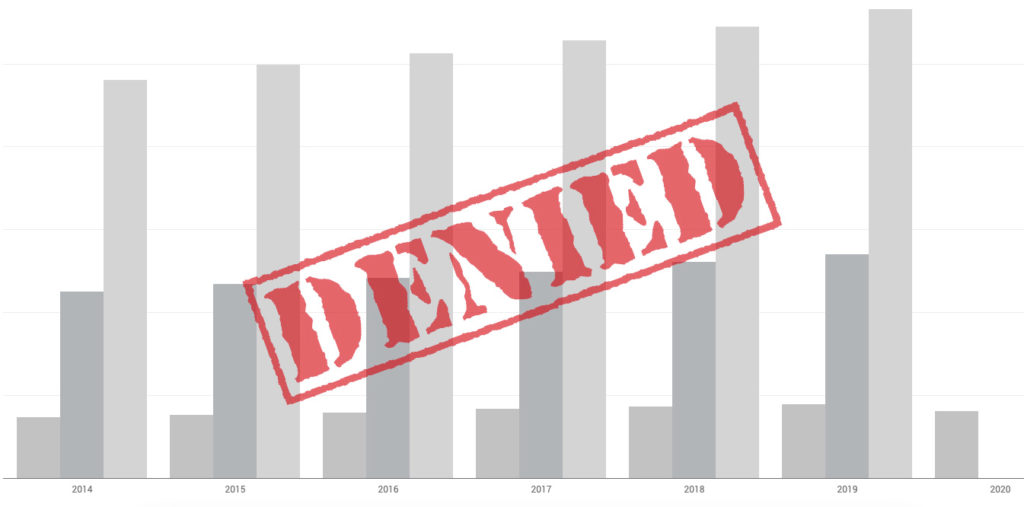
Note: The Monitor requested information regarding the number of personnel assigned to the Division of Protection of Individuals and Security of the National Civilian Police. However, the Ministry of the Interior denied our request, citing that disclosure of this information would “risk the life and integrity of police personnel” and pose a “risk against the national security system.”
Source: Ministry of the Interior.
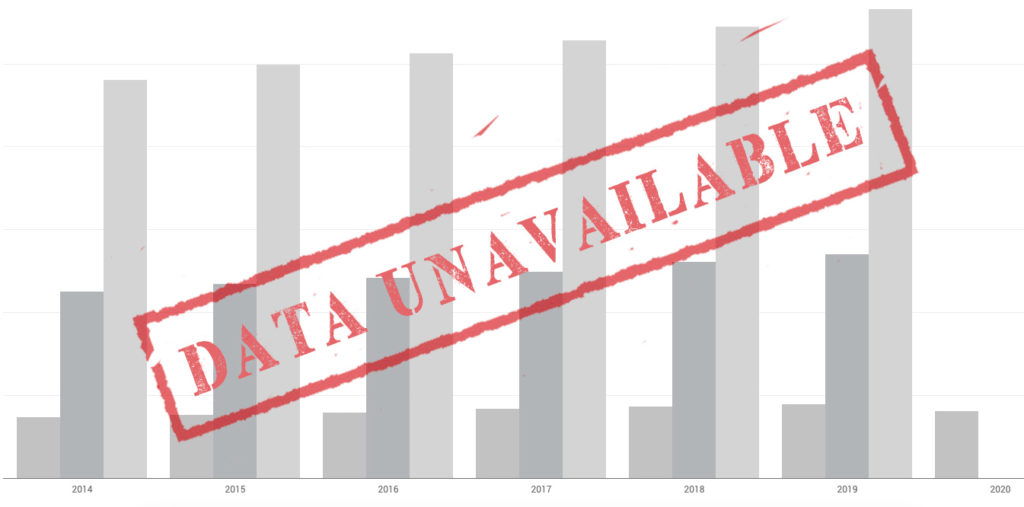
Note: The Ministry of the Interior does not track budget allocation or execution for the Division of Protection of Individuals and Security.
Honduras, Guatemala and El Salvador have among the world’s highest homicide rates and high rates of extortion and sexual violence, even though the latter are gravely underreported. We chose these crimes, because while homicide is the serious crime that most affects males, sexual violence is the serious crime that most affects females, and extortion affects broad segments of all sectors of society. We show how few cases actually enter the justice system and end in sentencing, thus creating a cycle of impunity for even the worst crimes.
-
Staff in Specialized Prosecutorial Units Staff in Specialized Judicial Tribunals Funds Allocated to Specialized Judicial Tribunals Staff in Specialized Police Units Funds Allocated to Specialized Police Units Staff in Specialized Forensic Medicine Units Funds Allocated to Specialized Forensic Medicine Units Staff in Specialized Public Defender's Units
!function(){“use strict”;window.addEventListener(“message”,(function(e){if(void 0!==e.data[“datawrapper-height”]){var t=document.querySelectorAll(“iframe”);for(var a in e.data[“datawrapper-height”])for(var r=0;r<t.length;r++){if(t[r].contentWindow===e.source)t[r].style.height=e.data["datawrapper-height"][a]+"px"}}}))}();
Source: Public Prosecutor’s Office of Guatemala.
!function(){“use strict”;window.addEventListener(“message”,(function(e){if(void 0!==e.data[“datawrapper-height”]){var t=document.querySelectorAll(“iframe”);for(var a in e.data[“datawrapper-height”])for(var r=0;r<t.length;r++){if(t[r].contentWindow===e.source)t[r].style.height=e.data["datawrapper-height"][a]+"px"}}}))}();
Sources: National Civilian Police and Diálogos of Guatemala.
!function(){“use strict”;window.addEventListener(“message”,(function(e){if(void 0!==e.data[“datawrapper-height”]){var t=document.querySelectorAll(“iframe”);for(var a in e.data[“datawrapper-height”])for(var r=0;r<t.length;r++){if(t[r].contentWindow===e.source)t[r].style.height=e.data["datawrapper-height"][a]+"px"}}}))}();
Source: Public Prosecutor’s Office of Guatemala.
!function(){“use strict”;window.addEventListener(“message”,(function(e){if(void 0!==e.data[“datawrapper-height”]){var t=document.querySelectorAll(“iframe”);for(var a in e.data[“datawrapper-height”])for(var r=0;r<t.length;r++){if(t[r].contentWindow===e.source)t[r].style.height=e.data["datawrapper-height"][a]+"px"}}}))}();
Source: Public Prosecutor’s Office of Guatemala.
!function(){“use strict”;window.addEventListener(“message”,(function(e){if(void 0!==e.data[“datawrapper-height”]){var t=document.querySelectorAll(“iframe”);for(var a in e.data[“datawrapper-height”])for(var r=0;r<t.length;r++){if(t[r].contentWindow===e.source)t[r].style.height=e.data["datawrapper-height"][a]+"px"}}}))}();
Source: Public Prosecutor’s Office of Guatemala.
!function(){“use strict”;window.addEventListener(“message”,(function(e){if(void 0!==e.data[“datawrapper-height”]){var t=document.querySelectorAll(“iframe”);for(var a in e.data[“datawrapper-height”])for(var r=0;r<t.length;r++){if(t[r].contentWindow===e.source)t[r].style.height=e.data["datawrapper-height"][a]+"px"}}}))}();
Source: Public Prosecutor’s Office of Guatemala.
!function(){“use strict”;window.addEventListener(“message”,(function(e){if(void 0!==e.data[“datawrapper-height”]){var t=document.querySelectorAll(“iframe”);for(var a in e.data[“datawrapper-height”])for(var r=0;r<t.length;r++){if(t[r].contentWindow===e.source)t[r].style.height=e.data["datawrapper-height"][a]+"px"}}}))}();
Source: Public Prosecutor’s Office of Guatemala.
!function(){“use strict”;window.addEventListener(“message”,(function(e){if(void 0!==e.data[“datawrapper-height”]){var t=document.querySelectorAll(“iframe”);for(var a in e.data[“datawrapper-height”])for(var r=0;r<t.length;r++){if(t[r].contentWindow===e.source)t[r].style.height=e.data["datawrapper-height"][a]+"px"}}}))}();
Note: Figures for specialized prosecutorial offices represent the number of prosecutors and assistant prosecutors I and II. Figures for specialized units and directorates represent the total number of personnel. No data was available for the quantity of personnel in the Asset Recovery Unit or Analysis Unit.
Source: Public Prosecutor’s Office.
!function(){“use strict”;window.addEventListener(“message”,(function(e){if(void 0!==e.data[“datawrapper-height”]){var t=document.querySelectorAll(“iframe”);for(var a in e.data[“datawrapper-height”])for(var r=0;r<t.length;r++){if(t[r].contentWindow===e.source)t[r].style.height=e.data["datawrapper-height"][a]+"px"}}}))}();
Source: Judiciary of Guatemala.
!function(){“use strict”;window.addEventListener(“message”,(function(e){if(void 0!==e.data[“datawrapper-height”]){var t=document.querySelectorAll(“iframe”);for(var a in e.data[“datawrapper-height”])for(var r=0;r<t.length;r++){if(t[r].contentWindow===e.source)t[r].style.height=e.data["datawrapper-height"][a]+"px"}}}))}();
Source: Judiciary of Guatemala.
!function(){“use strict”;window.addEventListener(“message”,(function(e){if(void 0!==e.data[“datawrapper-height”]){var t=document.querySelectorAll(“iframe”);for(var a in e.data[“datawrapper-height”])for(var r=0;r<t.length;r++){if(t[r].contentWindow===e.source)t[r].style.height=e.data["datawrapper-height"][a]+"px"}}}))}();
Note: In addition to the information shown in the graphs on specialized police units, the Monitor requested information regarding finances and human resources from three specialized divisions: the Specialized Criminal Investigation Division, the National Division against Criminal Gang Activity, and the Special Investigative Methods Division. However, the Ministry of the Interior denied information about the assigned personnel, with the justification that it would put national security at risk. Separately, the Ministry indicated it could not report on the finances of these divisions, since they fall under the Sub-Directorate General for Criminal Investigation and do not have independent budgets.
Source: Ministry of the Interior.
!function(){“use strict”;window.addEventListener(“message”,(function(e){if(void 0!==e.data[“datawrapper-height”]){var t=document.querySelectorAll(“iframe”);for(var a in e.data[“datawrapper-height”])for(var r=0;r<t.length;r++){if(t[r].contentWindow===e.source)t[r].style.height=e.data["datawrapper-height"][a]+"px"}}}))}();
Note: In addition to the information shown in the graphs on specialized police units, the Monitor requested information regarding finances and human resources from three specialized divisions: the Specialized Criminal Investigation Division, the National Division against Criminal Gang Activity, and the Special Investigative Methods Division. However, the Ministry of the Interior denied information about the assigned personnel, with the justification that it would put national security at risk. Separately, the Ministry indicated it could not report on the finances of these divisions, since they fall under the Sub-Directorate General for Criminal Investigation and do not have independent budgets.
Source: Ministry of the Interior.
!function(){“use strict”;window.addEventListener(“message”,(function(e){if(void 0!==e.data[“datawrapper-height”]){var t=document.querySelectorAll(“iframe”);for(var a in e.data[“datawrapper-height”])for(var r=0;r<t.length;r++){if(t[r].contentWindow===e.source)t[r].style.height=e.data["datawrapper-height"][a]+"px"}}}))}();
Note: All the laboratories shown in the chart fall under the Forensic Laboratory Unit (ULEC). The Computer Forensics Laboratory was established in 2017, so there is no data before this year. The Linguistics and Acoustics Laboratory changed its name between 2017 and 2018 to the Forensic Acoustics Laboratory. As of 2014, the Serology Laboratory and the Genetics Laboratory operated independently, but were combined as of 2018. Given this change, the chart combines data for these two laboratories in all years.
Source: National Institute of Forensic Science.
!function(){“use strict”;window.addEventListener(“message”,(function(e){if(void 0!==e.data[“datawrapper-height”]){var t=document.querySelectorAll(“iframe”);for(var a in e.data[“datawrapper-height”])for(var r=0;r<t.length;r++){if(t[r].contentWindow===e.source)t[r].style.height=e.data["datawrapper-height"][a]+"px"}}}))}();
Note: The figures shown refer to funds allocated to the Forensic Laboratory Unit. All amounts have been converted to United States Dollars using an exchange rate of 7.7 Guatemalan Quetzales.
Source: National Institute of Forensic Science.
!function(){“use strict”;window.addEventListener(“message”,(function(e){if(void 0!==e.data[“datawrapper-height”]){var t=document.querySelectorAll(“iframe”);for(var a in e.data[“datawrapper-height”])for(var r=0;r<t.length;r++){if(t[r].contentWindow===e.source)t[r].style.height=e.data["datawrapper-height"][a]+"px"}}}))}();
Note: The Specialized National Office for High Risk Cases was formally established in May 2017. High risk cases prior to this date were assigned at the departmental level. Figures shown for this entity and for the National Office for Free Legal Counsel for Victims and their Family Members represent the total number of personnel.
Source: Institute of Criminal Public Defense.
Guatemala has characteristics of a kleptocratic state, with illicit networks at every level that have penetrated most public and private institutions. This is part of why inequality and poverty persist, because the money meant for public services is misdirected. Through public confidence surveys, we show that citizens know these dynamics, and thus, do not trust their institutions, despite existing laws. These frameworks are not enough in the face of lacking willingness and capacity. Given how pervasive corruption is, we present how few cases of the seven most impactful crimes – abuse of authority, bribery, embezzlement, fraud, illicit enrichment, influence peddling, illicit financing, and malfeasance – actually get reported. Within this small sample of reported crimes, we show how few cases actually enter the justice system and end in sentencing. Even in these, the sentences are incredibly light, demonstrating at every step that authorities do not actually seek to tackle corruption.
!function(){“use strict”;window.addEventListener(“message”,(function(e){if(void 0!==e.data[“datawrapper-height”]){var t=document.querySelectorAll(“iframe”);for(var a in e.data[“datawrapper-height”])for(var r=0;r<t.length;r++){if(t[r].contentWindow===e.source)t[r].style.height=e.data["datawrapper-height"][a]+"px"}}}))}();
Note: The figures represent each country’s score and ranking on Transparency International’s Corruption Perceptions Index, which measures the perceived levels of public sector corruption in some 180 countries.
Source: Transparency International.
!function(){“use strict”;window.addEventListener(“message”,(function(e){if(void 0!==e.data[“datawrapper-height”]){var t=document.querySelectorAll(“iframe”);for(var a in e.data[“datawrapper-height”])for(var r=0;r<t.length;r++){if(t[r].contentWindow===e.source)t[r].style.height=e.data["datawrapper-height"][a]+"px"}}}))}();
Note: The Prosecutor’s Office of Internal Affairs did not yet exist in 2014.
Source: Public Prosecutor’s Office.
!function(){“use strict”;window.addEventListener(“message”,(function(e){if(void 0!==e.data[“datawrapper-height”]){var t=document.querySelectorAll(“iframe”);for(var a in e.data[“datawrapper-height”])for(var r=0;r<t.length;r++){if(t[r].contentWindow===e.source)t[r].style.height=e.data["datawrapper-height"][a]+"px"}}}))}();
Note: The Prosecutor’s Office of Internal Affairs did not yet exist in 2014. All amounts have been converted to United States Dollars using an exchange rate of 7.7 Guatemalan Quetzales.
Source: Public Prosecutor’s Office.
!function(){“use strict”;window.addEventListener(“message”,(function(e){if(void 0!==e.data[“datawrapper-height”]){var t=document.querySelectorAll(“iframe”);for(var a in e.data[“datawrapper-height”])for(var r=0;r<t.length;r++){if(t[r].contentWindow===e.source)t[r].style.height=e.data["datawrapper-height"][a]+"px"}}}))}();
Note: The figures show staff for High Risk Courts.
Source: Judiciary of Guatemala.
!function(){“use strict”;window.addEventListener(“message”,(function(e){if(void 0!==e.data[“datawrapper-height”]){var t=document.querySelectorAll(“iframe”);for(var a in e.data[“datawrapper-height”])for(var r=0;r<t.length;r++){if(t[r].contentWindow===e.source)t[r].style.height=e.data["datawrapper-height"][a]+"px"}}}))}();
Note: The figures shown refer to funds allocated to High Risk Courts. All amounts have been converted to United States Dollars using an exchange rate of 7.7 Guatemalan Quetzales.
Source: Judiciary of Guatemala.
!function(){“use strict”;window.addEventListener(“message”,(function(e){if(void 0!==e.data[“datawrapper-height”]){var t=document.querySelectorAll(“iframe”);for(var a in e.data[“datawrapper-height”])for(var r=0;r<t.length;r++){if(t[r].contentWindow===e.source)t[r].style.height=e.data["datawrapper-height"][a]+"px"}}}))}();
Source: Comptroller General’s Office.
!function(){“use strict”;window.addEventListener(“message”,(function(e){if(void 0!==e.data[“datawrapper-height”]){var t=document.querySelectorAll(“iframe”);for(var a in e.data[“datawrapper-height”])for(var r=0;r<t.length;r++){if(t[r].contentWindow===e.source)t[r].style.height=e.data["datawrapper-height"][a]+"px"}}}))}();
Note: All amounts have been converted to United States Dollars using an exchange rate of 7.7 Guatemalan Quetzales.
Source: Comptroller General’s Office.
Despite ongoing efforts to reform and professionalize the police, abuses and crimes committed by them remain incredibly common. Such abuses must end before citizens can trust their security forces as protectors rather than additional persecutors. Likewise, equal or greater investment in the justice system and social sectors is critical. Thus, we have focused the information in this section on the abuses being recorded and the personnel and budgetary resources available, so that the reader can compare across institutions.
-
Enrollment and Graduation at PNC Academy by Sex Enrollment and Graduation at PNC Academy by Ethnicity Enrollment and Graduation at Police Officer School by Sex Enrollment and Graduation at Police Officer School by Ethnicity Enrollment and Graduation at Police School for Specialization by Sex Enrollment and Graduation at Police School for Specialization by Ethnicity Enrollment and Graduation at Police School of Superior Studies by Sex Promotions by Level Promotions by Sex
-
Personnel Assigned to the Disciplinary System Disciplinary Proceedings for Minor Infractions by Level Disciplinary Proceedings for Serious Infractions by Level Disciplinary Proceedings for Very Serious Infractions by Level Penalties Levied by Level and Sex Penalties Levied by Type of Penalty and Sex Penalties Levied by Level and Seriousness of Infraction Investigations Initiated by Office of Professional Responsibility by Level Complaints Remitted to Public Prosecutor's Office Complaints, Proceedings Initiated, and Penalties Levied for Sexual Harassment
!function(){“use strict”;window.addEventListener(“message”,(function(e){if(void 0!==e.data[“datawrapper-height”]){var t=document.querySelectorAll(“iframe”);for(var a in e.data[“datawrapper-height”])for(var r=0;r<t.length;r++){if(t[r].contentWindow===e.source)t[r].style.height=e.data["datawrapper-height"][a]+"px"}}}))}();
Source: Ministry of the Interior.
!function(){“use strict”;window.addEventListener(“message”,(function(e){if(void 0!==e.data[“datawrapper-height”]){var t=document.querySelectorAll(“iframe”);for(var a in e.data[“datawrapper-height”])for(var r=0;r<t.length;r++){if(t[r].contentWindow===e.source)t[r].style.height=e.data["datawrapper-height"][a]+"px"}}}))}();
Source: Ministry of the Interior.
!function(){“use strict”;window.addEventListener(“message”,(function(e){if(void 0!==e.data[“datawrapper-height”]){var t=document.querySelectorAll(“iframe”);for(var a in e.data[“datawrapper-height”])for(var r=0;r<t.length;r++){if(t[r].contentWindow===e.source)t[r].style.height=e.data["datawrapper-height"][a]+"px"}}}))}();
Note: The Ministry of the Interior indicated it did not have records for personnel disaggregated by subdivision for 2014 or 2015. Only partial information was available for 2018 and 2019.
Source: Ministry of the Interior.
!function(){“use strict”;window.addEventListener(“message”,(function(e){if(void 0!==e.data[“datawrapper-height”]){var t=document.querySelectorAll(“iframe”);for(var a in e.data[“datawrapper-height”])for(var r=0;r<t.length;r++){if(t[r].contentWindow===e.source)t[r].style.height=e.data["datawrapper-height"][a]+"px"}}}))}();
Source: Ministry of the Interior.
!function(){“use strict”;window.addEventListener(“message”,(function(e){if(void 0!==e.data[“datawrapper-height”]){var t=document.querySelectorAll(“iframe”);for(var a in e.data[“datawrapper-height”])for(var r=0;r<t.length;r++){if(t[r].contentWindow===e.source)t[r].style.height=e.data["datawrapper-height"][a]+"px"}}}))}();
Source: Ministry of the Interior.
!function(){“use strict”;window.addEventListener(“message”,(function(e){if(void 0!==e.data[“datawrapper-height”]){var t=document.querySelectorAll(“iframe”);for(var a in e.data[“datawrapper-height”])for(var r=0;r<t.length;r++){if(t[r].contentWindow===e.source)t[r].style.height=e.data["datawrapper-height"][a]+"px"}}}))}();
Source: Ministry of the Interior.
!function(){“use strict”;window.addEventListener(“message”,(function(e){if(void 0!==e.data[“datawrapper-height”]){var t=document.querySelectorAll(“iframe”);for(var a in e.data[“datawrapper-height”])for(var r=0;r<t.length;r++){if(t[r].contentWindow===e.source)t[r].style.height=e.data["datawrapper-height"][a]+"px"}}}))}();
Source: Ministry of the Interior.
!function(){“use strict”;window.addEventListener(“message”,(function(e){if(void 0!==e.data[“datawrapper-height”]){var t=document.querySelectorAll(“iframe”);for(var a in e.data[“datawrapper-height”])for(var r=0;r<t.length;r++){if(t[r].contentWindow===e.source)t[r].style.height=e.data["datawrapper-height"][a]+"px"}}}))}();
Source: Ministry of the Interior.
!function(){“use strict”;window.addEventListener(“message”,(function(e){if(void 0!==e.data[“datawrapper-height”]){var t=document.querySelectorAll(“iframe”);for(var a in e.data[“datawrapper-height”])for(var r=0;r<t.length;r++){if(t[r].contentWindow===e.source)t[r].style.height=e.data["datawrapper-height"][a]+"px"}}}))}();
Source: Ministry of the Interior.
!function(){“use strict”;window.addEventListener(“message”,(function(e){if(void 0!==e.data[“datawrapper-height”]){var t=document.querySelectorAll(“iframe”);for(var a in e.data[“datawrapper-height”])for(var r=0;r<t.length;r++){if(t[r].contentWindow===e.source)t[r].style.height=e.data["datawrapper-height"][a]+"px"}}}))}();
Source: Ministry of the Interior.
!function(){“use strict”;window.addEventListener(“message”,(function(e){if(void 0!==e.data[“datawrapper-height”]){var t=document.querySelectorAll(“iframe”);for(var a in e.data[“datawrapper-height”])for(var r=0;r<t.length;r++){if(t[r].contentWindow===e.source)t[r].style.height=e.data["datawrapper-height"][a]+"px"}}}))}();
Source: Ministry of the Interior.
!function(){“use strict”;window.addEventListener(“message”,(function(e){if(void 0!==e.data[“datawrapper-height”]){var t=document.querySelectorAll(“iframe”);for(var a in e.data[“datawrapper-height”])for(var r=0;r<t.length;r++){if(t[r].contentWindow===e.source)t[r].style.height=e.data["datawrapper-height"][a]+"px"}}}))}();
Source: Ministry of the Interior.
!function(){“use strict”;window.addEventListener(“message”,(function(e){if(void 0!==e.data[“datawrapper-height”]){var t=document.querySelectorAll(“iframe”);for(var a in e.data[“datawrapper-height”])for(var r=0;r<t.length;r++){if(t[r].contentWindow===e.source)t[r].style.height=e.data["datawrapper-height"][a]+"px"}}}))}();
Source: Ministry of the Interior.
!function(){“use strict”;window.addEventListener(“message”,(function(e){if(void 0!==e.data[“datawrapper-height”]){var t=document.querySelectorAll(“iframe”);for(var a in e.data[“datawrapper-height”])for(var r=0;r<t.length;r++){if(t[r].contentWindow===e.source)t[r].style.height=e.data["datawrapper-height"][a]+"px"}}}))}();
Source: Ministry of the Interior.
!function(){“use strict”;window.addEventListener(“message”,(function(e){if(void 0!==e.data[“datawrapper-height”]){var t=document.querySelectorAll(“iframe”);for(var a in e.data[“datawrapper-height”])for(var r=0;r<t.length;r++){if(t[r].contentWindow===e.source)t[r].style.height=e.data["datawrapper-height"][a]+"px"}}}))}();
Source: Ministry of the Interior.
!function(){“use strict”;window.addEventListener(“message”,(function(e){if(void 0!==e.data[“datawrapper-height”]){var t=document.querySelectorAll(“iframe”);for(var a in e.data[“datawrapper-height”])for(var r=0;r<t.length;r++){if(t[r].contentWindow===e.source)t[r].style.height=e.data["datawrapper-height"][a]+"px"}}}))}();
Source: Ministry of the Interior.
!function(){“use strict”;window.addEventListener(“message”,(function(e){if(void 0!==e.data[“datawrapper-height”]){var t=document.querySelectorAll(“iframe”);for(var a in e.data[“datawrapper-height”])for(var r=0;r<t.length;r++){if(t[r].contentWindow===e.source)t[r].style.height=e.data["datawrapper-height"][a]+"px"}}}))}();
Note: All amounts have been converted to United States Dollars using an exchange rate of 7.7 Guatemalan Quetzales.
Source: Ministry of the Interior.
!function(){“use strict”;window.addEventListener(“message”,(function(e){if(void 0!==e.data[“datawrapper-height”]){var t=document.querySelectorAll(“iframe”);for(var a in e.data[“datawrapper-height”])for(var r=0;r<t.length;r++){if(t[r].contentWindow===e.source)t[r].style.height=e.data["datawrapper-height"][a]+"px"}}}))}();
Note: All amounts have been converted to United States Dollars using an exchange rate of 7.7 Guatemalan Quetzales.
Source: Ministry of the Interior.
!function(){“use strict”;window.addEventListener(“message”,(function(e){if(void 0!==e.data[“datawrapper-height”]){var t=document.querySelectorAll(“iframe”);for(var a in e.data[“datawrapper-height”])for(var r=0;r<t.length;r++){if(t[r].contentWindow===e.source)t[r].style.height=e.data["datawrapper-height"][a]+"px"}}}))}();
Note: The figures shown refer to funds allocated to each subdivision. All amounts have been converted to United States Dollars using an exchange rate of 7.7 Guatemalan Quetzales.
Source: Ministry of the Interior.
!function(){“use strict”;window.addEventListener(“message”,(function(e){if(void 0!==e.data[“datawrapper-height”]){var t=document.querySelectorAll(“iframe”);for(var a in e.data[“datawrapper-height”])for(var r=0;r<t.length;r++){if(t[r].contentWindow===e.source)t[r].style.height=e.data["datawrapper-height"][a]+"px"}}}))}();
Note: The figures shown refer to base salaries for each position. The base salary did not change between 2014 and 2020. All amounts have been converted to United States Dollars using an exchange rate of 7.7 Guatemalan Quetzales.
Source: Ministry of the Interior.
!function(){“use strict”;window.addEventListener(“message”,(function(e){if(void 0!==e.data[“datawrapper-height”]){var t=document.querySelectorAll(“iframe”);for(var a in e.data[“datawrapper-height”])for(var r=0;r<t.length;r++){if(t[r].contentWindow===e.source)t[r].style.height=e.data["datawrapper-height"][a]+"px"}}}))}();
Note: The Ministry of the Interior provided information on personnel assigned to its internal disciplinary system through 2018. However, in 2019, the Ministry denied our request for this information, citing the pretext that its disclosure would pose “risks against the national security system, criminal investigations, and state intelligence.”
Source: Ministry of the Interior.
!function(){“use strict”;window.addEventListener(“message”,(function(e){if(void 0!==e.data[“datawrapper-height”]){var t=document.querySelectorAll(“iframe”);for(var a in e.data[“datawrapper-height”])for(var r=0;r<t.length;r++){if(t[r].contentWindow===e.source)t[r].style.height=e.data["datawrapper-height"][a]+"px"}}}))}();
Source: Ministry of the Interior.
!function(){“use strict”;window.addEventListener(“message”,(function(e){if(void 0!==e.data[“datawrapper-height”]){var t=document.querySelectorAll(“iframe”);for(var a in e.data[“datawrapper-height”])for(var r=0;r<t.length;r++){if(t[r].contentWindow===e.source)t[r].style.height=e.data["datawrapper-height"][a]+"px"}}}))}();
Source: Ministry of the Interior.
!function(){“use strict”;window.addEventListener(“message”,(function(e){if(void 0!==e.data[“datawrapper-height”]){var t=document.querySelectorAll(“iframe”);for(var a in e.data[“datawrapper-height”])for(var r=0;r<t.length;r++){if(t[r].contentWindow===e.source)t[r].style.height=e.data["datawrapper-height"][a]+"px"}}}))}();
Source: Ministry of the Interior.
Note: The Ministry of the Interior indicated that it did not have records regarding the number of penalties for dismissal from service imposed in 2014 and 2015, so partial data is shown for these years.
Source: Ministry of the Interior.
!function(){“use strict”;window.addEventListener(“message”,(function(e){if(void 0!==e.data[“datawrapper-height”]){var t=document.querySelectorAll(“iframe”);for(var a in e.data[“datawrapper-height”])for(var r=0;r<t.length;r++){if(t[r].contentWindow===e.source)t[r].style.height=e.data["datawrapper-height"][a]+"px"}}}))}();
Note: The Ministry of the Interior indicated that it did not have records regarding the number of penalties for dismissal from service imposed in 2014 and 2015, so partial data is shown for these years.
Source: Ministry of the Interior.
!function(){“use strict”;window.addEventListener(“message”,(function(e){if(void 0!==e.data[“datawrapper-height”]){var t=document.querySelectorAll(“iframe”);for(var a in e.data[“datawrapper-height”])for(var r=0;r<t.length;r++){if(t[r].contentWindow===e.source)t[r].style.height=e.data["datawrapper-height"][a]+"px"}}}))}();
Note: The Ministry of the Interior indicated that it did not have records regarding the number of penalties for dismissal from service imposed in 2014 and 2015, so partial data is shown for these years.
Source: Ministry of the Interior.
!function(){“use strict”;window.addEventListener(“message”,(function(e){if(void 0!==e.data[“datawrapper-height”]){var t=document.querySelectorAll(“iframe”);for(var a in e.data[“datawrapper-height”])for(var r=0;r<t.length;r++){if(t[r].contentWindow===e.source)t[r].style.height=e.data["datawrapper-height"][a]+"px"}}}))}();
Source: Ministry of the Interior.
!function(){“use strict”;window.addEventListener(“message”,(function(e){if(void 0!==e.data[“datawrapper-height”]){var t=document.querySelectorAll(“iframe”);for(var a in e.data[“datawrapper-height”])for(var r=0;r<t.length;r++){if(t[r].contentWindow===e.source)t[r].style.height=e.data["datawrapper-height"][a]+"px"}}}))}();
Source: Ministry of the Interior.
!function(){“use strict”;window.addEventListener(“message”,(function(e){if(void 0!==e.data[“datawrapper-height”]){var t=document.querySelectorAll(“iframe”);for(var a in e.data[“datawrapper-height”])for(var r=0;r<t.length;r++){if(t[r].contentWindow===e.source)t[r].style.height=e.data["datawrapper-height"][a]+"px"}}}))}();
Source: Ministry of the Interior.
The justice system faces numerous challenges. To provide national context to the other sections and a jumping-off point for comparisons with other countries outside the region, we display the global totals of all crimes, budget, staff and particularly relevant personnel for three categories: the prosecution, judiciary and public defense.
!function(){“use strict”;window.addEventListener(“message”,(function(e){if(void 0!==e.data[“datawrapper-height”]){var t=document.querySelectorAll(“iframe”);for(var a in e.data[“datawrapper-height”])for(var r=0;r<t.length;r++){if(t[r].contentWindow===e.source)t[r].style.height=e.data["datawrapper-height"][a]+"px"}}}))}();
Sources: Public Prosecutor’s Office; Judiciary of Guatemala; National Institute of Forensic Science; Institute of Criminal Public Defense.
!function(){“use strict”;window.addEventListener(“message”,(function(e){if(void 0!==e.data[“datawrapper-height”]){var t=document.querySelectorAll(“iframe”);for(var a in e.data[“datawrapper-height”])for(var r=0;r<t.length;r++){if(t[r].contentWindow===e.source)t[r].style.height=e.data["datawrapper-height"][a]+"px"}}}))}();
Note: Data regarding the number of prosecutors disaggregated by sex was not available.
Sources: Public Prosecutor’s Office; Judiciary of Guatemala; National Institute of Forensic Science; Institute of Criminal Public Defense.
!function(){“use strict”;window.addEventListener(“message”,(function(e){if(void 0!==e.data[“datawrapper-height”]){var t=document.querySelectorAll(“iframe”);for(var a in e.data[“datawrapper-height”])for(var r=0;r<t.length;r++){if(t[r].contentWindow===e.source)t[r].style.height=e.data["datawrapper-height"][a]+"px"}}}))}();
Sources: Public Prosecutor’s Office; Judiciary of Guatemala; National Institute of Forensic Science; Institute of Criminal Public Defense.
!function(){“use strict”;window.addEventListener(“message”,(function(e){if(void 0!==e.data[“datawrapper-height”]){var t=document.querySelectorAll(“iframe”);for(var a in e.data[“datawrapper-height”])for(var r=0;r<t.length;r++){if(t[r].contentWindow===e.source)t[r].style.height=e.data["datawrapper-height"][a]+"px"}}}))}();
Note: The figures shown refer to the number of prosecutors and assistant prosecutors. The Human Rights category includes personnel within the Public Prosecutor’s Office for Human Rights. The Corruption category includes personnel within the Prosecutor’s Office against Corruption, Prosecutor’s Office of Administrative Crimes, Prosecutor’s Office of Internal Affairs, and Special Prosecutor’s Office against Impunity. The Violence and Organized Crime category includes personnel within the Prosecutor’s Office for Organized Crime, Prosecutor’s Office for Drug-Related Crimes, Prosecutor’s Office for Money or Asset Laundering, Prosecutor’s Office for Extortion, Prosecutor’s Office for Human Trafficking, Prosecutor’s Office for Kidnapping, Prosecutor’s Office for Crimes against the Person, Prosecutor’s Office for Women, Prosecutor’s Office for Femicide, Specialized Unit against Criminal Organizations that Engage in Drug Trafficking and/or Money or Asset Laundering and Tax Crimes, Asset Recovery Unit, Special Investigative Methods Unit, Analysis Unit, Criminal Analysis Division, and Forensic Investigation Division.
Source: Public Prosecutor’s Office.
!function(){“use strict”;window.addEventListener(“message”,(function(e){if(void 0!==e.data[“datawrapper-height”]){var t=document.querySelectorAll(“iframe”);for(var a in e.data[“datawrapper-height”])for(var r=0;r<t.length;r++){if(t[r].contentWindow===e.source)t[r].style.height=e.data["datawrapper-height"][a]+"px"}}}))}();
Note: The Violence and Organized Crime category includes personnel within Criminal Sentencing Courts in Crimes of Femicide and Other Forms of Violence against Women. Guatemala’s High Risk Courts share their jurisdiction between the categories of Human Rights, Corruption, and Violence and Organized crime, so staffing figures for these entities are reflected separately in the chart.
Source: Judiciary of Guatemala.
!function(){“use strict”;window.addEventListener(“message”,(function(e){if(void 0!==e.data[“datawrapper-height”]){var t=document.querySelectorAll(“iframe”);for(var a in e.data[“datawrapper-height”])for(var r=0;r<t.length;r++){if(t[r].contentWindow===e.source)t[r].style.height=e.data["datawrapper-height"][a]+"px"}}}))}();
Note: The IDPP does not have specialized personnel for Human Rights or Corruption categories. The figures shown refer to the Violence and Organized Crime category, and represent the total number of staff assigned to the Specialized National Office for High Risk Cases and the National Office for Free Legal Counsel for Victims and their Family Members.
Source: Institute of Criminal Public Defense.
!function(){“use strict”;window.addEventListener(“message”,(function(e){if(void 0!==e.data[“datawrapper-height”]){var t=document.querySelectorAll(“iframe”);for(var a in e.data[“datawrapper-height”])for(var r=0;r<t.length;r++){if(t[r].contentWindow===e.source)t[r].style.height=e.data["datawrapper-height"][a]+"px"}}}))}();
Note: All amounts have been converted to United States Dollars using exchange rates of 24.6 Honduran Lempiras and 7.7 Guatemalan Quetzales. The Violence and Organized Crime category includes funds allocated to Criminal Sentencing Courts in Crimes of Femicide and Other Forms of Violence against Women. Guatemala’s High Risk Courts share their jurisdiction between the categories of Human Rights, Corruption, and Violence and Organized crime, so funding figures for these entities are reflected separately in the chart.
Source: Judiciary of Guatemala.
!function(){“use strict”;window.addEventListener(“message”,(function(e){if(void 0!==e.data[“datawrapper-height”]){var t=document.querySelectorAll(“iframe”);for(var a in e.data[“datawrapper-height”])for(var r=0;r<t.length;r++){if(t[r].contentWindow===e.source)t[r].style.height=e.data["datawrapper-height"][a]+"px"}}}))}();
Source: Judiciary of Guatemala.
!function(){“use strict”;window.addEventListener(“message”,(function(e){if(void 0!==e.data[“datawrapper-height”]){var t=document.querySelectorAll(“iframe”);for(var a in e.data[“datawrapper-height”])for(var r=0;r<t.length;r++){if(t[r].contentWindow===e.source)t[r].style.height=e.data["datawrapper-height"][a]+"px"}}}))}();
Note: The figures show the criminal case load for the total number of prosecutors, since data was not available on the number of prosecutors in criminal matters in Guatemala.
Source: Public Prosecutor’s Office and National Institute of Statistics of Guatemala.
!function(){“use strict”;window.addEventListener(“message”,(function(e){if(void 0!==e.data[“datawrapper-height”]){var t=document.querySelectorAll(“iframe”);for(var a in e.data[“datawrapper-height”])for(var r=0;r<t.length;r++){if(t[r].contentWindow===e.source)t[r].style.height=e.data["datawrapper-height"][a]+"px"}}}))}();
Sources: Public Prosecutor’s Office and National Institute of Statistics.
!function(){“use strict”;window.addEventListener(“message”,(function(e){if(void 0!==e.data[“datawrapper-height”]){var t=document.querySelectorAll(“iframe”);for(var a in e.data[“datawrapper-height”])for(var r=0;r<t.length;r++){if(t[r].contentWindow===e.source)t[r].style.height=e.data["datawrapper-height"][a]+"px"}}}))}();
Sources: Institute of Criminal Public Defense and Public Prosecutor’s Office of Guatemala.
!function(){“use strict”;window.addEventListener(“message”,(function(e){if(void 0!==e.data[“datawrapper-height”]){var t=document.querySelectorAll(“iframe”);for(var a in e.data[“datawrapper-height”])for(var r=0;r<t.length;r++){if(t[r].contentWindow===e.source)t[r].style.height=e.data["datawrapper-height"][a]+"px"}}}))}();
Sources: National Institute of Forensic Science and National Institute of Statistics.

Note: No data is available on the number of cases pending at the start of each year in Guatemala.
!function(){“use strict”;window.addEventListener(“message”,(function(e){if(void 0!==e.data[“datawrapper-height”]){var t=document.querySelectorAll(“iframe”);for(var a in e.data[“datawrapper-height”])for(var r=0;r<t.length;r++){if(t[r].contentWindow===e.source)t[r].style.height=e.data["datawrapper-height"][a]+"px"}}}))}();
Source: Judiciary of Guatemala.
!function(){“use strict”;window.addEventListener(“message”,(function(e){if(void 0!==e.data[“datawrapper-height”]){var t=document.querySelectorAll(“iframe”);for(var a in e.data[“datawrapper-height”])for(var r=0;r<t.length;r++){if(t[r].contentWindow===e.source)t[r].style.height=e.data["datawrapper-height"][a]+"px"}}}))}();
Source: Judiciary of Guatemala.
!function(){“use strict”;window.addEventListener(“message”,(function(e){if(void 0!==e.data[“datawrapper-height”]){var t=document.querySelectorAll(“iframe”);for(var a in e.data[“datawrapper-height”])for(var r=0;r<t.length;r++){if(t[r].contentWindow===e.source)t[r].style.height=e.data["datawrapper-height"][a]+"px"}}}))}();
Source: Judiciary of Guatemala.
!function(){“use strict”;window.addEventListener(“message”,(function(e){if(void 0!==e.data[“datawrapper-height”]){var t=document.querySelectorAll(“iframe”);for(var a in e.data[“datawrapper-height”])for(var r=0;r<t.length;r++){if(t[r].contentWindow===e.source)t[r].style.height=e.data["datawrapper-height"][a]+"px"}}}))}();
Source: Public Prosecutor’s Office.
!function(){“use strict”;window.addEventListener(“message”,(function(e){if(void 0!==e.data[“datawrapper-height”]){var t=document.querySelectorAll(“iframe”);for(var a in e.data[“datawrapper-height”])for(var r=0;r<t.length;r++){if(t[r].contentWindow===e.source)t[r].style.height=e.data["datawrapper-height"][a]+"px"}}}))}();
Source: Public Prosecutor’s Office.
!function(){“use strict”;window.addEventListener(“message”,(function(e){if(void 0!==e.data[“datawrapper-height”]){var t=document.querySelectorAll(“iframe”);for(var a in e.data[“datawrapper-height”])for(var r=0;r<t.length;r++){if(t[r].contentWindow===e.source)t[r].style.height=e.data["datawrapper-height"][a]+"px"}}}))}();
Source: Judiciary of Guatemala.
In the first five years of CAM’s operation, the military in particular most denied our requests, such that we rarely got the information needed to monitor them. Furthermore, abuses and crimes committed by the military remained incredibly common – despite efforts at some points to limit their involvement in public security – and we were consistently able to get this information from other State institutions. Such abuses must end before citizens can trust their security forces as protectors rather than additional persecutors. Likewise, equal or greater investment in the justice system and social sectors is critical. Thus, we have focused the information in this section on the abuses being recorded and the personnel and budgetary resources available, so that the reader can compare across institutions.
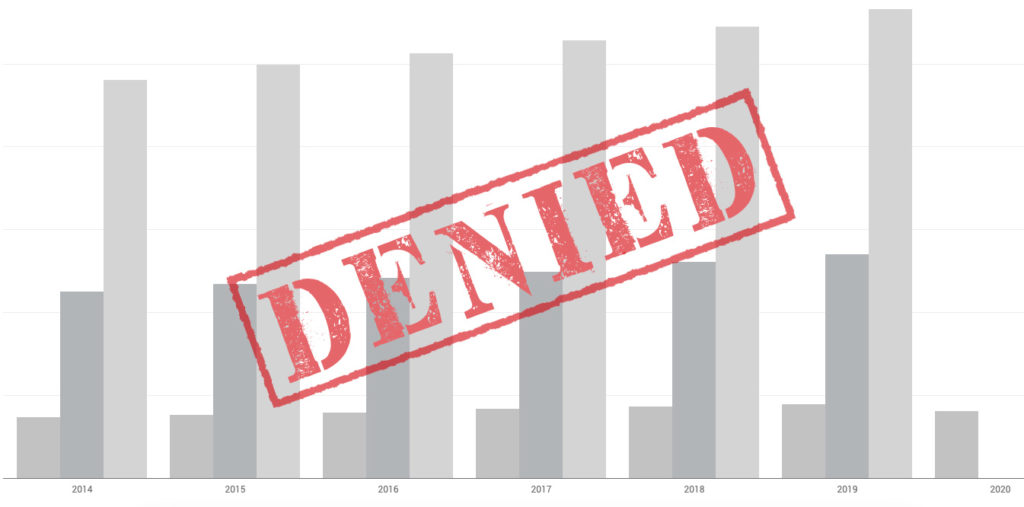
Note: The government denied all information requested by the Monitor regarding the number of military personnel or internal deployment of troops, arguing that disclosure of this information would jeopardize national security. The refusal to provide this information not only makes it impossible to perform a comprehensive analysis of the Armed Forces and their participation in internal police functions, but also represents an alarming tendency of opacity regarding civic oversight and accountability for possible human rights violations committed by this institution in the exercise of police functions.

Note: The government denied all information requested by the Monitor regarding the number of military personnel or internal deployment of troops, arguing that disclosure of this information would jeopardize national security. The refusal to provide this information not only makes it impossible to perform a comprehensive analysis of the Armed Forces and their participation in internal police functions, but also represents an alarming tendency of opacity regarding civic oversight and accountability for possible human rights violations committed by this institution in the exercise of police functions.

Note: The government denied all information requested by the Monitor regarding the number of military personnel or internal deployment of troops, arguing that disclosure of this information would jeopardize national security. The refusal to provide this information not only makes it impossible to perform a comprehensive analysis of the Armed Forces and their participation in internal police functions, but also represents an alarming tendency of opacity regarding civic oversight and accountability for possible human rights violations committed by this institution in the exercise of police functions.
!function(){“use strict”;window.addEventListener(“message”,(function(e){if(void 0!==e.data[“datawrapper-height”]){var t=document.querySelectorAll(“iframe”);for(var a in e.data[“datawrapper-height”])for(var r=0;r<t.length;r++){if(t[r].contentWindow===e.source)t[r].style.height=e.data["datawrapper-height"][a]+"px"}}}))}();
Note: All amounts have been converted to United States Dollars using an exchange rate of 7.7 Guatemalan Quetzales.
Source: Ministry of National Defense.
!function(){“use strict”;window.addEventListener(“message”,(function(e){if(void 0!==e.data[“datawrapper-height”]){var t=document.querySelectorAll(“iframe”);for(var a in e.data[“datawrapper-height”])for(var r=0;r<t.length;r++){if(t[r].contentWindow===e.source)t[r].style.height=e.data["datawrapper-height"][a]+"px"}}}))}();
Note: All amounts have been converted to United States Dollars using an exchange rate of 7.7 Guatemalan Quetzales.
Source: Ministry of National Defense.
!function(){“use strict”;window.addEventListener(“message”,(function(e){if(void 0!==e.data[“datawrapper-height”]){var t=document.querySelectorAll(“iframe”);for(var a in e.data[“datawrapper-height”])for(var r=0;r<t.length;r++){if(t[r].contentWindow===e.source)t[r].style.height=e.data["datawrapper-height"][a]+"px"}}}))}();
Note: All amounts have been converted to United States Dollars using an exchange rate of 7.7 Guatemalan Quetzales.
Source: Ministry of National Defense.
!function(){“use strict”;window.addEventListener(“message”,(function(e){if(void 0!==e.data[“datawrapper-height”]){var t=document.querySelectorAll(“iframe”);for(var a in e.data[“datawrapper-height”])for(var r=0;r<t.length;r++){if(t[r].contentWindow===e.source)t[r].style.height=e.data["datawrapper-height"][a]+"px"}}}))}();
Note: Not all PDH offices provided data for 2019, so the data shown for this year is incomplete.
Source: Human Rights Ombudsperson’s Office.

Note: The Monitor requested information regarding the number of cases of human rights violations investigated by Ministry of National Defense and remitted to the Public Prosecutor’s Office. However, the Ministry indicated that these data did not exist, citing that “the Ministry of National Defense does not conduct investigations.”
Our Partners
WOLA is working in collaboration with the following organizations in Central America:
 |
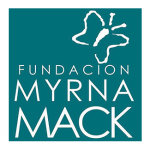 |
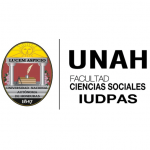 |
| University Institute of Public Opinion El Salvador |
Myrna Mack Foundation Guatemala |
Institute on Democracy, Peace & Security Honduras |

